How to properly sharpen knives with a whetstone - a short guide for beginners
The sharpening stone is used by both masters and beginners. You can sharpen a knife with a whetstone better and better than with a special unit. Human hands are the most precise and sensitive manipulator. Follow the simple instructions, and within 15–30 minutes your knife will be sharp again.
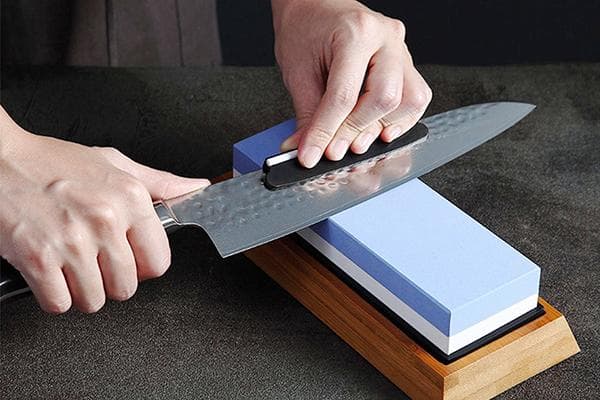
Preparation of the workplace
The first thing to do is prepare the tool and location. Sharpening is best done at a table. It is advisable to fix the sharpening stone to free up two hands. To do this, you can use this board:
To sharpen a knife you will need:
- grindstone;
- knife;
- container with water;
- magnifying glass;
- lamp;
- cloth
Before sharpening, the whetstone is well moistened (left in water for 15–20 minutes). The blade glides better on a wet block and sharpens faster and more evenly. In addition, water prevents metal shavings from scattering and clogging into the pores of the stone.
Knife preparation is also important. The first thing you need to do is wash it thoroughly. Then the blade is inspected using a magnifying glass and lamp. You need to pay attention to the sharpening angle and the presence of defects on the blade.
Sharpening stages
To achieve the best result, the knife sharpening process should consist of several stages:
- Removing the steel layer. For this, a high or medium abrasive sharpening stone (600-1000 grit) is used. The knife becomes sharp, but microscopic scratches are visible on its surface, and burrs may remain on the edge.
- Finishing.+ At this stage, all scratches are smoothed out and the blade acquires a mirror shine. The blade is polished on a fine-grained stone (over 1000 grit). GOI paste and a leather belt are also used for these purposes.
Very often, kitchen knives do not require sharpening, but straightening, that is, straightening the blade (bends form from strong impact on the edge). In this case, it is not necessary to remove the steel layer. The blade is trimmed against the butt of the second knife, musat or a smooth stone.
Bringing a knife to razor sharpness is a big mistake. A sharp blade dulls and bends much faster.
Technique
The most important things in sharpening knives:
- observe the factory angle;
- sharpen the blade evenly on both sides and along the entire cutting edge.
Don't try to sharpen your knife quickly. During the first sharpening, always check whether you are doing everything correctly. Examine the blade under a magnifying glass. Use a lamp to create highlights on the surface.
Setting the angle
To sharpen a knife, you need to hold it at a certain angle. If the blade is not severely damaged, stick to the factory sharpening.
- Pay attention to the angle at which the blade is beveled.
- Place the blade on the stone. It is necessary that the tip rests on the “beveled” edge.
- After performing 5-7 sliding movements, check whether you maintain the right angle.
If the factory sharpening is not visible or the blade is severely damaged, they are guided by generally accepted standards.
Depending on the type and purpose of the knife, the following sharpening angles are observed:
- regular kitchen – 25–35°;
- Japanese kitchen – 10–20°;
- professional chef for meat and fish – 25°;
- cooker for vegetables and fruits – 30°;
- dining room – 55–60°;
- cutting – 20–30°;
- tourist – 30–45°;
- hunting - from 10° to 30°.
The selected value is divided by two.That is, if you need a sharpening angle of 45°, the blade is held at an angle of 22.5°.
It is difficult to maintain the same inclination for a long time. Therefore, many people use special clamps that are attached to the blade. Here's what they look like:
Correct grip
As already mentioned, it is better to fix the block in a stand. Then you won't have to hold it. It is advisable to sharpen a knife with both hands.
Correct grip:
- The working hand clasps the handle. The hand is not tense and rotates freely.
- The fingers of the second hand lie on the blade as close to the tip as possible. The thumb rests on the butt.
Like this:
Movements
It’s better to practice sharpening on a knife that you don’t mind ruining. In this matter, it is not so much theory that is important as practice. It’s the same with playing musical instruments – your hands need to “get used” to certain actions.
How to sharpen a knife by hand:
- You need to move your hands freely and smoothly.
- The movements are long and uniform.
- You should strive to draw the entire length of the blade (diagonally) at a time.
- For beginners, it is better to sharpen the knife on both sides alternately (once on one and the other).
- It is correct to lead the knife first away from you, and then, turning it over the butt, towards you.
Pressure
Do not put too much pressure on the blade. When force is applied, the steel layer will be removed unevenly and deep scratches will appear. The cutting edge will become uneven and wavy. It is correct to only lightly press the knife against the block. Imagine that you need to cut off a neat layer of butter.
You can determine the correct pressure by sound. The sliding of the blade should be accompanied by a slight “teal” sound, but not a “grinding” sound.
A dull knife not only cuts food poorly, but also often causes injuries and cuts. To cut anything, you have to apply force. Often the blade slips and a cut occurs. Therefore, knives need to be sharpened regularly. The whetstone is one of the most popular sharpening tools for the home. Anyone can learn to use it. It is enough to understand the technique and practice a little.
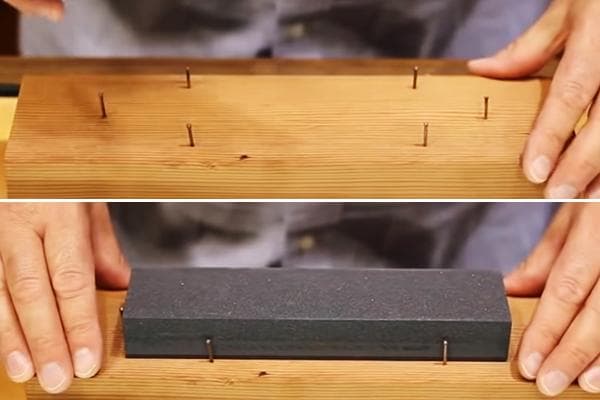
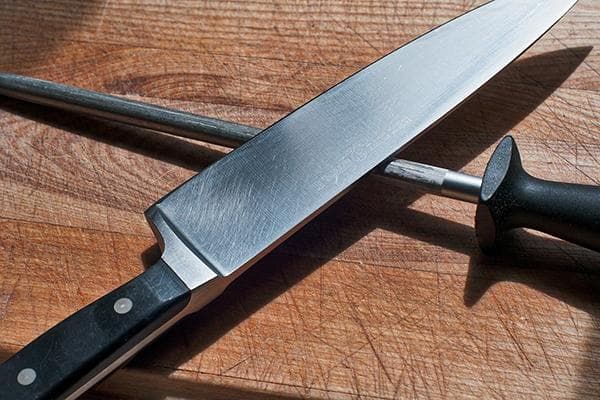
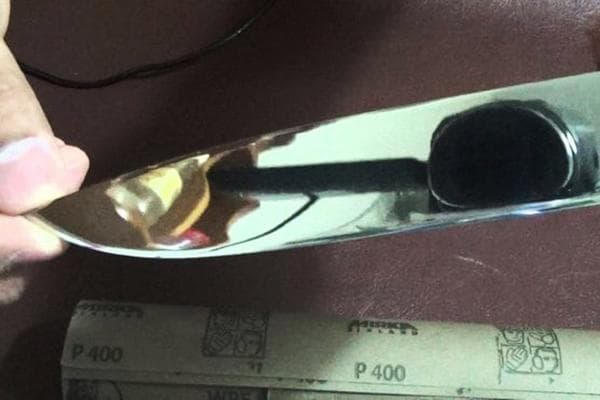
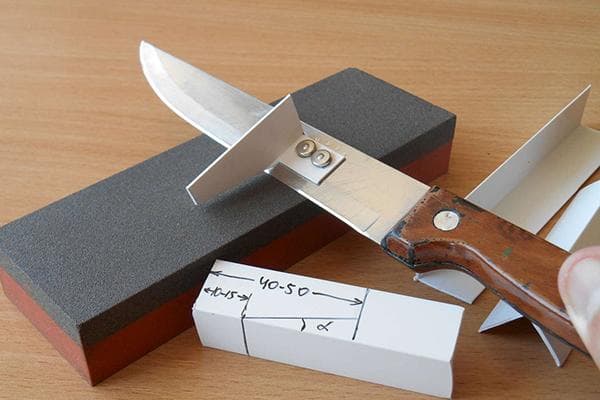
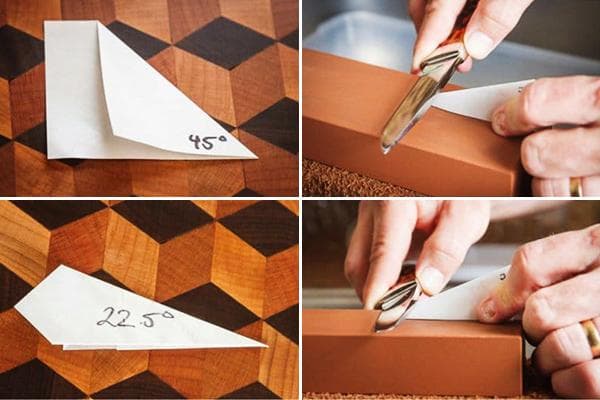
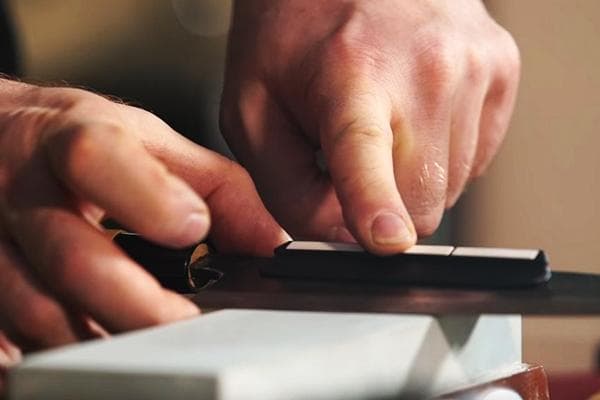
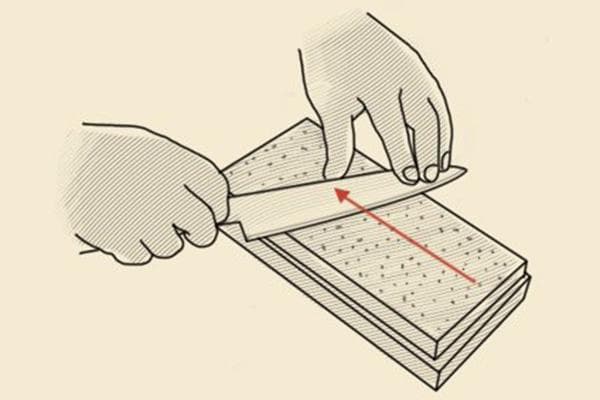
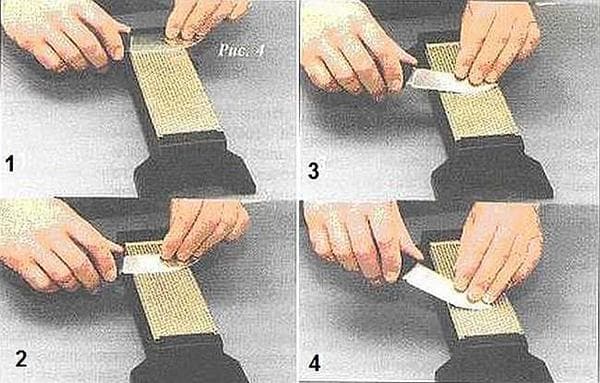
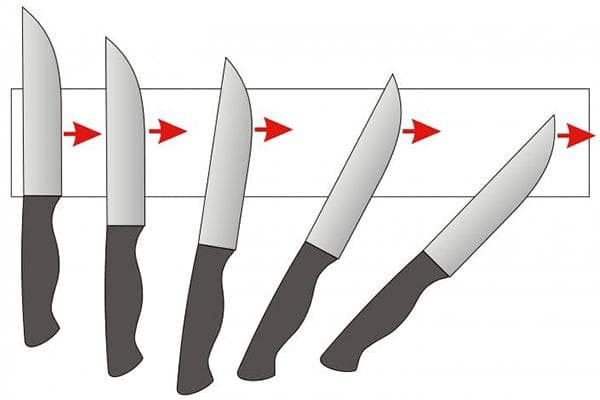
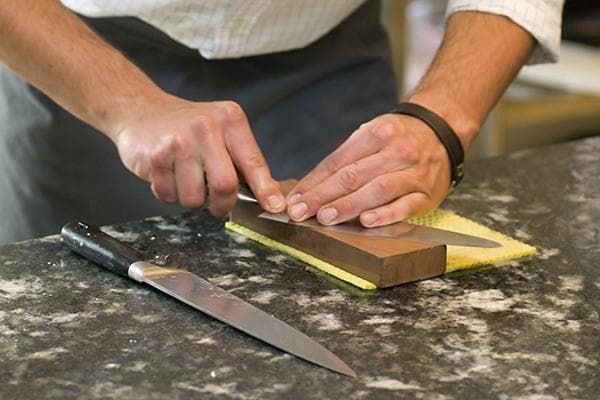
This should be called academic sharpening of a knife blade. A simple, economic, vital action was elevated to the rank of madness. Spend so much effort and energy just to slash a bone or wool once when cutting and start all over again. The knife needs sharpening, but a sharpening knife is offered. In life, sharpening is done once - during manufacturing, and then only editing, no matter what, as long as it cuts. At the same time, the price of a knife whose blade holds its sting and edits quickly. All!
Nothing to add
The knife is dull, the author is even dumber
Best comment!
These academicians are fed up with sharpening. At first you think that they are simply resisting for the sake of advertising unsaleable sharpening accessories. But then you understand - no matter what the child amuses himself with, as long as he doesn’t cry... Some people collect matchboxes, some bottle caps, some methods of sharpening knives are absolutely useless to anyone except those who collect them!!!
I support! It takes 15 to 30 minutes to sharpen a kitchen knife once sharpened?!))) I’ve been using whetstones for over 40 years now, I wouldn’t drive nails into a table yet)), and in this case water is only needed to wash the whetstone, well, or 2, and then dry them for further use, clean and not worn out. In general, there was no need to pour so much water into this “lesson” when two straight hands and a block are enough, although sometimes straight hands alone are enough to straighten the knife to a razor sharpness.Strangely enough, a woman taught me how to sharpen knives and razors, about 45 years ago, she worked for 35 years as a men's hairdresser in those days when hairdressers shaved men with straight razors, my dear grandmother, the kingdom. as they say, she's in heaven. And after that, her science was useful to me in my professions as a mechanic, a mechanic, a carpenter and a joiner, and in housekeeping too. Young people have a strange idea - if you have a super-duper tool and work according to some forgotten instructions from some guru of some profession, then you are a master! I’ll tell you a simple secret - the master has his own secrets, taking into account the accumulated experience in the profession, and not the gadgets with which he surrounds himself, in general it’s simple, but you’ll have to spend years.))
It's nice to meet a like-minded person. I’m already in my eighties, and I made almost all the knives for the house myself. There was such an opportunity. The blades were mainly made self-sharpening, i.e. not an angle, but a radius.
A dull knife will kill a scribbler nimnoshka..
Exactly. And then you just need to find a GOOD Chinese knife, cut it with a knife 5-6 times - and the knife is ready. I’ve had this Chinese device in my kitchen for about 15 years and I use it.
Yes, when I made myself a knife from a Damascus steel blade, I sharpened it in exactly this way. Spent two hours on this. Now, if necessary, only fine-tuning.
Author, have you looked at your article? The pictures indicate the direction of movement of the knife in different directions. In the video, the man first sharpens with a movement towards the butt, turns the knife over and makes a movement towards the blade. Conclusion: author - You are an inattentive ignoramus, you can’t sharpen a knife properly, you’ll fail the RK. That's all I wanted to say.
Nikolai, can you read, or do you just look at pictures? Ask someone to read the text above the pictures, only slowly and twice.
And to Victor and Nikolai... Unfortunately, our Russian language, like the laws written in it, means that wherever you turn the drawbar, it ends up there. This is what the expression means: movement towards the butt???? Therefore, even commentaries are issued on the criminal code, otherwise a normal person does not understand the perverted logic of the authors. Personally, I understood how to sharpen knives from this article. Maybe you can write it in English, or even better, in German? These languages are more logical and unambiguous, alas...
Sharpening and straightening are different processes.
People! What are you writing? There are no self-sharpening knives, scissors, etc. in nature. This was invented for advertising so that people would believe in such a miracle! So don’t believe in all sorts of sharpening angles and radii.
Tell me, are we really talking about kitchen knives?
Is everything okay???
Where's the microscope?
The author has made something too complicated. You can defend your candidate's thesis.
When sharpening, it is advisable to ensure continuous rinsing of chip particles either with lubricant or with a running stream of water. This will be much more effective, since the shavings clog the pores of the stone and worsen its properties. In addition, it is advisable to use the entire surface of the stone evenly, since at the point of contact, part of the abrasive is erased along with the chips and a barely noticeable dip can form in the stone in its middle part. This dip can affect the sharpening angle control.
you, Alexander, are wrong. If it is a good knife and the right stone, then the emulsion that appears during sharpening does not need to be washed off. Fuck it! it is even specially created as a separate pebble.
And if it’s a cheap knife and a simple stone, then to hell with them, with everyone. I fiddled with a piece of iron and it was good.
OK
Well done man for sharing, thank you. Some people will like this information.
It will appeal to those who are languishing from idleness, “no matter what the child amuses himself with...”.
professional knives are sharpened on professional machines and not on the same stone \ here you only need to look at the pictures to understand that this is complete nonsense and crap
The founder of the Japanese company TOJIRO sharpens knives on the Stone. You can find a video on the Internet. Very entertaining. Knives have a hardness of more than 60; it is better not to damage them on mechanical machines.
Here you also need a microscope, preferably an electronic one, a laser protractor and long training for the correct position of your hands and knife. Thank you, author, for such a story! During this time I will sharpen 10 knives.
Just give you a reason!
The knives become dull. Only people get dumb :)
Great article!!!
Chic, shine, sharpness!
Unfortunately, I have no idea!
Yes. The dude is blunt, like all his knives.
The recommendations in the article are correct, but sharpening a knife by hand with high quality is very difficult, especially maintaining an angle, and as a result, ordinary people will end up with nothing. Few people have sandpaper of different grain sizes, and there are also a small number of people who have such high-quality knives that need to be sharpened at a certain angle to obtain sharpness for carving hair or paper by weight. After all, the sharpening angle also depends on the hardness of the knife steel. However, the recommendations in the article will really help you sharpen a knife at home on a block from the hardware store. But perfect sharpening will not work on it, even if the angle can be kept straight - from use, the block is ground into a semicircle in the central part. For this purpose, professionals also have bars for “sharpening” - leveling the bars.In general, this is a rare nerd, take the Chinese edge pro apex sharpener on Aliexpress if you really want to get an ideal surface at a certain angle, and 2-3 bars at once (for example, 600 800 1000 grit). Moreover, there are also diamond ones for ceramic points. In general, the author is a great guy, and those who scold him for nothing are fools themselves!
Right
Right
I sharpen knives as my father taught me: a block, a knife and my hands. the wife is happy. My brother can't do it. I come to visit and his wife immediately dumps out knives for me to sharpen.
There is so much nonsense in the article that I don’t even want to waste time analyzing it. I'll say one thing. The lady “teaches” life to novice fools, with a pretense of omniscience and greatness. 15 - 30 minutes and your knife is sharp. Sharpening a knife, and even by hand, requires hard work and patience. Besides, if the lady is a pro, where are her photos of how she sharpens knives? I got it from the Internet - learn from me! I can’t help but remember Mr. Antibiotk, with his statement about “women”!
Who the hell wrote this? Another creature who has read a lot of Google and imagines himself a sharpening master))) everything is much simpler and faster
All problems with dull knives can be solved once and for all by purchasing a roller ceramic sharpener from Fiskars. I’ve been using it for 20 years. I probably gave 50 of these as a gift. The description is on the Ikea website. Similar ones produced under a patent in the USA and Japan are very inferior to the original.
Hmmm..... Dear Young Lady teaches everyone and everything how to sharpen knives...
But the question is, how will you sharpen 110X19?
I also have a knife made from self-propelled steel, I made it myself.
And lastly, two Sputnik knives. What and how to sharpen?
Esli ruki rastut is right place - nog budet ostriy.Avtor Molodez, eto posobie dlya neumelzev. Nastoyazhiy mujchina doljen horosho tochit knife. Nado uchitsya u myasnikov…)))
I always welcome perfectionism, but in this case these are tips for people who are overly concerned.
A good sharpener for 500-1000 rubles eliminates the problem of sharp knives in the kitchen for 15-20 years. “Squeeze” it a few times every couple of months and don’t think about the above science.
Take care of yourselves citizens and be happy.
It's like sharpening a samurai sword
everything is written out in an interesting and informative way, but it’s crazy how impractical it is.. insert a grinding attachment with fine sandpaper into the screwdriver.. 5-6 movements and the knife is back to work.. crawling carefully over the stone is interesting when the master is in front of tourists.. and at home.. unless play on my wife’s nerves….
from Damascus ???????????????????????????????????????????????? ?77
It looks like the author has nothing better to do.
I wonder if anyone sharpens table knives? ? Seriously? And it’s doubtful about sharpening Japanese knives at an angle of 10 degrees.. Even with one-sided sharpening, there should be at least 20, otherwise the edge will fly off right away.. Recommendations on the grain size of the stone are also very vague. Yes, and for straightening the edge of the blade, musat also helps. There are many questions, no answers. And one more thing - the sharpening time and the ability of the blade to hold an edge still depend on the hardness of the steel. Something like this.
ok article, but the second side is blurry, just burn the comments of the majors about sharpening at the factory, I wish you success, write, but the main thing is good, useful and practical!
Do not laugh. One guy here posted material on his feed about how to wipe your butt correctly and economically. It turns out that this is a whole art, akin to ballet and rhythmic gymnastics.It turns out that even the terrain (forest, clearing, hillock, hole, push, etc.) is important, as well as consumables, which can be folded after each wave of the hand up to four (!) times. And this will be more important than your knife, because... no delay.
I can't help but laugh...
Everything is correct! However, there are still subtleties. As practice shows, cutting yourself with a sharp knife is faster. Therefore, for a more (dull) sharpening, some sharpeners sharpen along the blade. In this case, the marks formed from the abrasive grains are in any case not parallel to the blade; the result is a blade with a sparse tooth, which is applicable only for soft materials. From your classic sharpening (saw) the blade is obtained with a fine tooth, which brings more progressive cutting, even of hard materials. You say, what about razor sharpening, super sharp with a polished surface? Look at a razor blade under a microscope and you will see the micro marks that form this cutting file. Speaking of cutting, the cutting shape is a wedge! The abrasive grains are wedge-shaped. Therefore, grinding can be called polishing with the speed and depth inherent in any cutting. Next about the wet abrasive stone. There are water treatment options here. The author apparently has in mind the option of frequently washing off chipped abrasive grains and metal particles from the surface. This way we can achieve a given depth of abrasive cutting and, accordingly, the pitch (teeth) of our (saw) in accordance with the grain size of the abrasive. However, in the absence of a set of abrasive whetstones and having only one with a coarse grain, you can achieve fine sharpening if you do not wash off chipped abrasive particles and metal particles from the surface of a once-wetted whetstone.In this case, the cutting depth will decrease as the space is filled with waste particles. between the abrasive grains. The block is partially salted. With this method of sharpening, the saw blade will be variable with alternating frequent, small and rare high teeth, this can create versatility of use.
Please challenge the above based on the physical and mechanical properties of materials and processing processes.
Vanya, is this a clumsy Yandex translation from English? Did you understand what you wrote?
This is what I understand - the dude approached the topic with all responsibility. And he opened it so deeply. And it’s a fact - YOU CAN’T DISPUTE (based on the physical and mechanical properties of materials)
they write to earn money and we are fools, reading all sorts of nonsense and even discussing
nonsense. Just sharpen the kitchen knife...magnifying glass...they also forgot the protractor to check the sharpening angle
EVERYTHING IS CORRECT AND COMPLETE
Sausage cut with this knife will be 5 times tastier. Has the author heard of sharpeners? How lazy do you have to be to spend so much time of your life on this process? Maybe this time can be spent on making money and buying normal knives/sharpeners?
I didn't even read it. This is what self-isolation does to people.
If you brought table knives, sharpened for the catering unit, you would call in 1-2 hours. This is because soft table steel does not hold the sting. Although necessary
An additional technique you briefly mentioned is the edit “knife, on the knife (not on the butt)”, when struck, micro notches are formed.
I witnessed when a carpenter-sharpener of table steel, the cook was, to put it mildly, condemned.
The problem is to buy a good block. Who can tell me where to buy.
Just before May, a lesson so as not to leave the house.
About 15 years ago I bought one set of German knives for the kitchen and dining room at the same time, on a wooden stand: a chef’s knife, a “toothed” bread knife. long kitchen, fish, vegetable and “common” medium size.
The set includes 6 “food” knives (serve at the table for 6 people).
The form of “vegetable” (peeling potatoes) seemed strange at first, but then we got used to it and appreciated it.
One “food” knife, over these 15 years, has already broken on the metal, inside the handle. Another one, the same - the wooden handle was weakened. This is where all the breakdowns ended.
We use knives every day.
How many times have you sharpened them?
Never! NOT AT ALL!
The set includes musat. Musat does not “sharpen”, musat “rules”. ONE is COMPLETELY enough.
And using “sharpeners” only spoils well-made knives.
Crap! I’d rather bite it off or break it off...
I bought a round file for saws and don’t worry
straightening with a diamond file and without any stones
educational program for morons
This is how the blacksmith sharpened it and taught it to the author. I immediately remind you that the knife is caught correctly like this: not across the block with the blade forward, and not from heel to toe - that’s how fools sharpen. The knife goes diagonally along the block from tip to heel, then turns over and again from the tip of the knife to heels. Move only forward, alternately turning the blade over. Next, the degree of sharpening depends only on the thickness of the butt of the knife - the thinner the butt, the sharper the angle. Finishing the knife on a shallow counter, covered with liquid soap, then on a leather belt.
but I have a simple Japanese knife and no stone = it won’t take it. and you're talking about pastas here. Can you recommend toothpaste?
But I’ve been sharpening knives for many years, but I still haven’t learned how!
and I have a homemade knife from a file (I gave it to heat treatment so that the blade could be made). So more than one drill won’t take it to screw the handle on (so I had to weld through it). And what kind of stone can you use to sharpen it by hand? It’s hard to sharpen it when you sharpen it. Well, if he spends a year, maybe he’ll sharpen it ha-ha-ha
Such a sharpener would have been kicked out of work in no time.
The dullness of a knife depends on the dullness of the sharpener
I remember how guys walked around Moscow with pedal-driven sharpeners and shouted “sharpening knives, scissors.”
Recently I was in Tbilisi and heard the same text in Russian through the window.
I was in a daze for a minute, I thought the time machine had worked. The same guy with a pedal grinding wheel.
So what am I talking about? This sharpening lesson is for this guy.
I wish I could hear this text! Mom don't worry! All comments would stand aside.
EVERYTHING IS CORRECT, THE KNIFE HAS BEEN SHARPENED. IF HE'S STUPID. BUT MORE OFTEN WE USE KITCHEN KNIVES THAT ALREADY HAVE A GOOD SHARPENING. THE STRAIGHT RAZOR IS STRAIGHT ON THE BELT. SO YOU SHOULD MONITOR THE KNIFE, DON’T LEAVE IT, AND CORRECT IT IN TIME. IT'S MUCH EASIER AND YOU DON'T NEED SUCH GIRL AND DEVICES. GREEN CORUD OR NULL SKIN ON THE GLASS.
What if you need to sharpen 10 dead knives in 25 minutes? And so that people could work with them for a day.
It's funny? Maria, you should also write a textbook for this most banal action. Next we are waiting for a scientific article on how to wipe yourself correctly and safely!
Good quality knives are sharpened every few years and only trimmed in between, unless of course this is a professional kitchen.
For some, sharpening is a hobby, sharpening knives on Japanese water stones and then testing them on a Malinsky rope, well, God bless them.
For practical purposes, there are a lot of gadgets that help you maintain a more or less constant sharpening angle. The successful females, in my opinion, are this:
Spyderco Tri-Angle Sharpmaker Knife Sharpening System
Well, yes, that’s what I do in the haymaking :)))
You walk through a meadow and wave your scythe. As soon as the scythe becomes dull, I immediately take out a table, a chair, a table lamp, a magnifying glass, a sharpening stone, soak a sharpening stone in water for 15 minutes, remove the scythe from the shaft and off I go to straighten it at the desired angle. In half an hour - like new, you can return to haymaking again...
Chinese “Lansky” 4000 rubles in the store, even cheaper on Aliexpress. Knives of any shape at any angle. 4 stones included.
All this is bullshit!
My wife tormented me: “the knives at home are dull, the knives at home are dull,” but the fact that the children at home are dull does not bother her.
For the correct angle and correct editing, sharpening, a special Ruxin Pro machine and spare parts for it are sold on Aliexpress: bars [stone and diamond], fastening screws, etc.